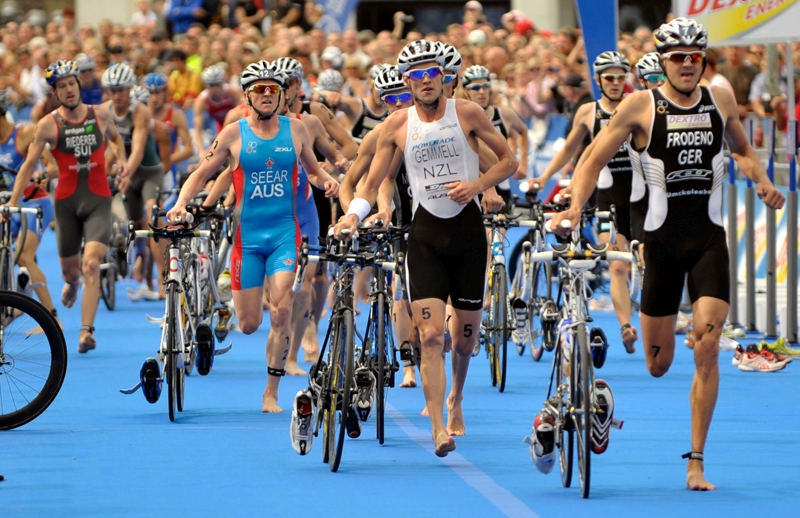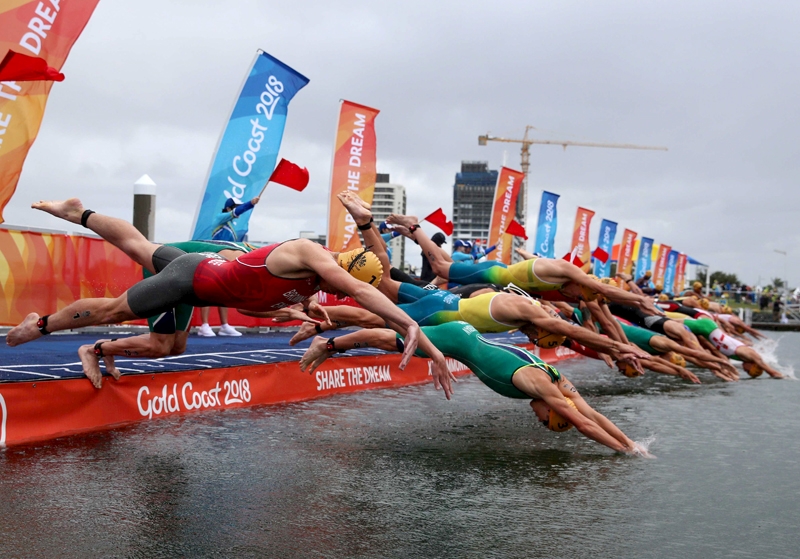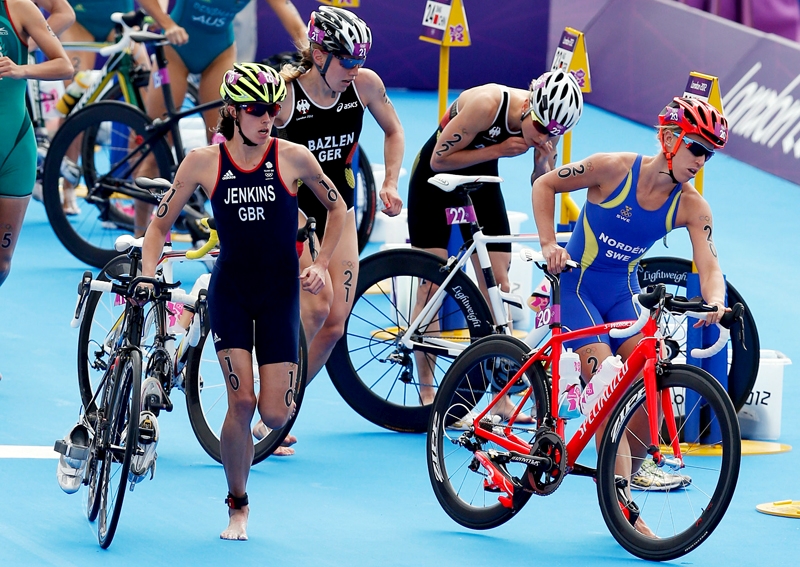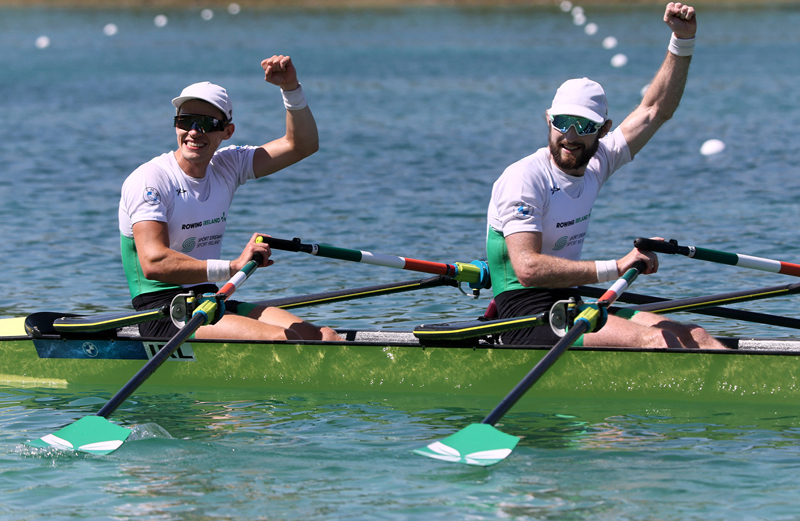You are viewing 1 of your 1 free articles. For unlimited access take a risk-free trial
Triathlon bike-run transitions: jump to it!

Is there any specific training that can help triathletes find their 'running legs' more rapidly following the bike segment? Andrew Hamilton looks at the evidence
All triathletes know the feeling of leaping off the bike, donning their running shoes and setting off for the final leg; the brain’s still thinking in circles when what the legs really want it to do is to switch into stride mode! Sports scientists have discovered that the reason for these awkward bike-run transition sensations in the legs is because of changes in the neuromotor control system that occur after long periods of cycling and which take a while to reverse once running commences. We know this to be the case because research has shown that a period of cycling immediately prior to running subtly changes the movement patterns in those muscles involved in the running action as measured at the pelvis and in the lower limbs(1).Training the transition
The research referred to above also established that cycling-related changes to neuromotor control of running muscles is temporary – perhaps lasting only 5-15 minutes. But in shorter-distance triathlons, that’s still enough to harm your performance in the run leg. The obvious question therefore is whether there’s any specific training that triathletes can perform, which might minimise this effect? One fascinating study by Aussie researchers suggests that some simple conditioning exercise could indeed help minimise the discomfort of the initial running period following the bike-run transition, helping triathletes to get into their natural stride more rapidly(2).In this study, fifteen triathletes were split into two groups and performed one of the two following protocols for eight weeks:
- *Endurance-only training.
- *Endurance plus ‘plyometrics training’, which consisted of three sessions of 30 minutes per week of increasing difficulty (for those unfamiliar with this kind of training, plyometrics involves loading a muscle then contracting it rapidly (eg jumping off a platform then springing upwards immediately after landing) to increase the speed, force and ‘explosiveness’ of muscular contractions).
The results showed that after the intervention period, 100% of the triathletes in the plyometric group exhibited muscle recruitment patterns during running after cycling that more closely resembled the recruitment patterns used during an isolated run. In the endurance-only group however, only 40% of the triathletes improved their neuromotor control – a significant difference.
Implications for triathletes
This research consisted of only one relatively small study, and since its publication, there’s been no follow-up research specifically looking at plyometrics for training the bike-run transition in triathlon. However, the benefits observed in the triathletes who performed the plyometrics training were very significant. Therefore, it does seem to indicate that by adding (a relatively small amount of) plyometrics into their training routine, triathletes could gain a real time advantage in a race situation thanks to a better bike-run transition.For those of you unfamiliar with plyometrics, figure 1 shows the kind of exercises that you can incorporate into your strength and conditioning sessions. Bear in mind though that as with any kind of training, the effects are reversible, which means the benefits start to ebb away once that specific type of training is ceased. This means that the best time to start incorporating plyometrics into your programme would be in the two to three-month run up to an event. Make sure however that you don’t train right up to the event – dropping any plyometrics training a couple of weeks beforehand is recommended to ensure you get plenty of rest and recovery during your taper period. Triathletes are also directed to this article, in which other methods and techniques to improve the bike-run transition are discussed.
Figure 1: Examples of commonly used and effective plyometrics exercises

NB: If you are new to plyometrics, here are some key principles to bear in mind. For a full and proper explanation of how to perform these commonly-used exercises, you are directed to John Shepherd’s Sports Performance Bulletin article, which you can find here and in the links below.
*Surface – It’s best to perform plyos on a running track. Suitable alternatives include sprung gym floors or dry flat grass.
*Speed of movement – Always focus on the ‘quickness’ of your reactions – don’t lever yourself out of jumps. Land light and move quickly.
*Be in the moment – Focus on what you are doing and get your neural system fully switched on. It’s your brain signalling that will make the movements fast (as well as developed relevant strength and familiarity).
*Don’t overdo it – Build up slowly, and as mentioned, underestimate what you think you can achieve initially. Expect to experience some muscle soreness but this should be a rare occurrence once you include plyos regularly into your workouts.
*Watch for fatigue – If you notice that your reactions and ground contacts are slowing then take longer recoveries or stop the session. You are looking for quality of movement that maximises neuromuscular connection.
References
- J Sports Sci. 2010 Nov;28(13):1477-87
- Phys Ther Sport. 2011 Feb;12(1):15-21
Newsletter Sign Up
Testimonials
Dr. Alexandra Fandetti-Robin, Back & Body Chiropractic
Elspeth Cowell MSCh DpodM SRCh HCPC reg
William Hunter, Nuffield Health
Newsletter Sign Up
Coaches Testimonials
Dr. Alexandra Fandetti-Robin, Back & Body Chiropractic
Elspeth Cowell MSCh DpodM SRCh HCPC reg
William Hunter, Nuffield Health
Keep up with latest sports science research and apply it to maximize performance
Today you have the chance to join a group of athletes, and sports coaches/trainers who all have something special in common...
They use the latest research to improve performance for themselves and their clients - both athletes and sports teams - with help from global specialists in the fields of sports science, sports medicine and sports psychology.
They do this by reading Sports Performance Bulletin, an easy-to-digest but serious-minded journal dedicated to high performance sports. SPB offers a wealth of information and insight into the latest research, in an easily-accessible and understood format, along with a wealth of practical recommendations.
*includes 3 coaching manuals
Get Inspired
All the latest techniques and approaches
Sports Performance Bulletin helps dedicated endurance athletes improve their performance. Sense-checking the latest sports science research, and sourcing evidence and case studies to support findings, Sports Performance Bulletin turns proven insights into easily digestible practical advice. Supporting athletes, coaches and professionals who wish to ensure their guidance and programmes are kept right up to date and based on credible science.












